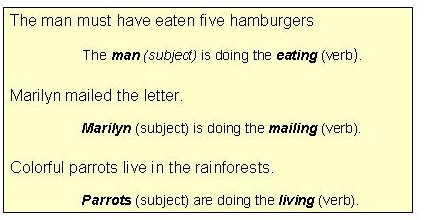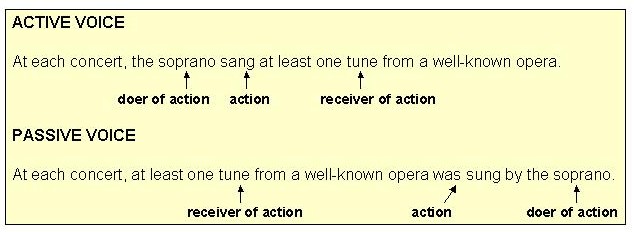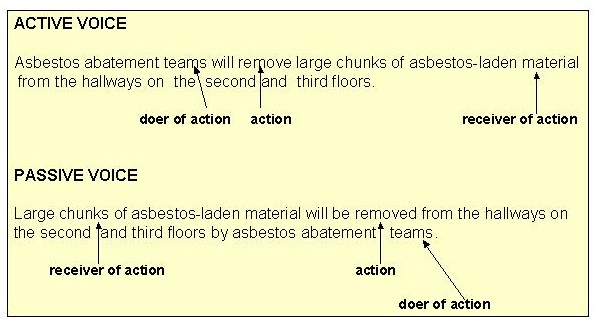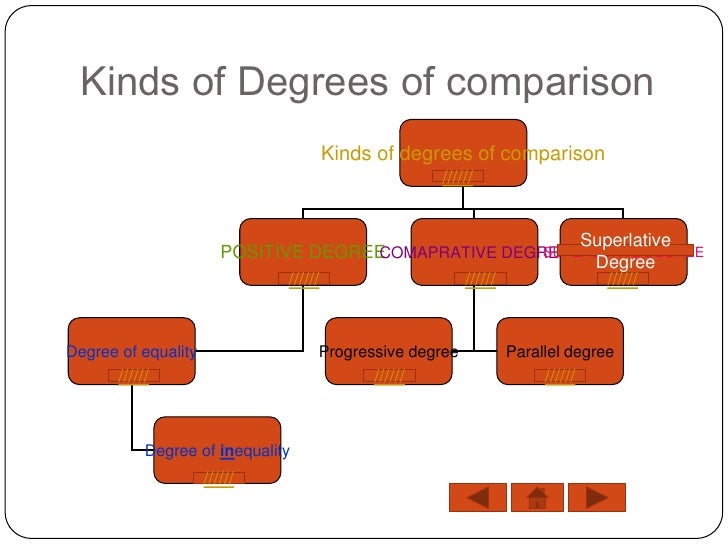Wednesday 31 January 2018
Thursday 25 January 2018
Active and Passive voice
ACTIVE / PASSIVE VOICE
Active voiceIn most English sentences with an action verb, the subject performs the action denoted by the verb.
These examples show that the subject is doing the verb's action.

Because the subject does or "acts upon" the verb in such sentences, the sentences are said to be in the active voice.
Passive voice
One can change the normal word order of many active sentences (those with a direct object) so that the subject is no longer active, but is, instead, being acted upon by the verb - or passive.
Note in these examples how the subject-verb relationship has changed.

Because the subject is being "acted upon" (or is passive), such sentences are said to be in the passive voice.
NOTE: Colorful parrots live in the rainforests cannot be changed to passive voice because the sentence does not have a direct object.
To change a sentence from active to passive voice, do the following:
1. Move the active sentence's direct object into the sentence's subject slot

2. Place the active sentence's subject into a phrase beginning with the preposition by

3. Add a form of the auxiliary verb be to the main verb and change the main verb's form

Because passive voice sentences necessarily add words and change the normal doer-action-receiver of action direction, they may make the reader work harder to understand the intended meaning.
As the examples below illustrate, a sentence in active voice flows more smoothly and is easier to understand than the same sentence in passive voice.


It is generally preferable to use the ACTIVE voice.
To change a passive voice sentence into an active voice sentence, simply reverse the steps shown above.
1. Move the passive sentence's subject into the active sentence's direct object slot

2. Remove the auxiliary verb be from the main verb and change main verb's form if needed

3. Place the passive sentence's object of the preposition by into the subject slot.

Because it is more direct, most writers prefer to use the active voice whenever possible.
The passive voice may be a better choice, however, when
- the doer of the action is unknown, unwanted, or unneeded in the sentence

- the writer wishes to emphasize the action of the sentence rather than the doer of the action

- the writer wishes to use passive voice for sentence variety.
Communicable Disease -Heart Attack
Communicable Disease- Heart Attack
What is a heart attack?
Heart attack facts
- A heart attack results when a blood clot completely obstructs a coronary artery supplying blood to the heart muscle and heart muscle dies.
- The blood clot that causes the heart attack usually forms at the site of rupture of an atherosclerotic, cholesterol plaque on the inner wall of a coronary artery.
- The most common symptom of heart attack is chest pain.
- The most common complications of a heart attack are heart failure and ventricular fibrillation.
- The risk factors for atherosclerosis and heart attack include elevated cholesterol levels, increased blood pressure, tobacco use, diabetes, male gender, and a family history of heart attacks at an early age.
- Heart attacks are diagnosed with electrocardiograms and measurement of cardiac enzymes in blood.
- Treatment guidelines emphasize treatment at a hospital capable of doing PCI (percutaneous coronary intervention) also termed as stenting or stent placement.
- Early reopening of blocked coronary arteries reduces the amount of damage to the heart and improves the prognosis for a heart attack.
- Medical treatment for heart attacks may include antiplatelet, anticoagulant, and clot dissolving drugs as well as angiotensin converting enzyme (ACE) inhibitors, beta blockers, and oxygen.
- Interventional treatment for heart attacks may include coronary angiography with percutaneous transluminal coronary angioplasty (PTCA), coronary artery stents, and coronary artery bypass grafting (CABG).
- Patients suffering a heart attack are hospitalized for several days to detect heart rhythm disturbances, shortness of breath, and chest pain.
- Further heart attacks can be prevented by aspirin, beta blockers, ACE inhibitors, discontinuing smoking, weight reduction, exercise, good control of blood pressure and diabetes, following a low cholesterol and low saturated fat diet that is high in omega-3-fatty acids, taking multivitamins with an increased amount of folic acid, decreasing LDL cholesterol, and increasing HDL cholesterol.
PRINCIPLES OF CURRICULUM DEVELOPMENT
1. The principle of relevance; internally that have relevance in the curriculum between the components of the curriculum (goals, materials, strategies, organization and evaluation). While externally that the components tersebutmemiliki relevance to the demands of science and technology (epistomologis relevance), demand and potential learners (psychological relevance) and the demands and needs of the community development (relevance sosilogis).2. The principle of flexibility; in curriculum development effort that produced by nature flexible, supple and flexible in its implementation, allow for adjustments based on the situation and condition of the place and time is always growing, and the ability and background bekang learners.
3. The principle of continuity, namely the existence of kesinambungandalam curriculum, both vertically or horizontally. Learning experiences provided the curriculum should pay attention to sustainability, both inside the classroom level, between levels of education, as well as between levels of education with the type of work.
4. The principle of efficiency, ie see to it that can utilize in curriculum development time, cost, and other sources that there is an optimal, carefully and precisely so that the results adequately.
5. The principle of effectiveness; ie curriculum development activities seek to achieve goals without the wasteful activities, both in quality and quantity.
Related with Education Unit Level Curriculum development, there are some principles that must be met, namely:
Assessment in inclusive classrooms
Assessment practices in inclusive classrooms in pre-primary and primary education will be examined against the backdrop of ongoing educational reform and examples of good or best practice will be teased out and highlighted.Pre-Primary Education
Teachers are advised to conduct initial (or baseline) assessments in order to ascertain each pupil’s level of development on entry. Such assessment include obtaining information from parents through questionnaires and/or interviews regarding the medical and developmental history of pupils. It also includes observation, informal assessment or completion of more formal checklists (criterion based assessment). Teachers are provided with guidelines and samples of questionnaires and checklists but there is flexibility as to the use of particular methods and procedures especially if the school unit under the guidance of the head teacher adopts these. Areas assessed include psychomotor ability, language and communication skills, cognitive skills, emotional development, development of social skills and personal adjustment.There is heightened awareness among pre-primary teachers of the importance of early identification and intervention and pre-primary teachers are especially careful to refer any pupil showing problems in language and speech development. Moreover, in a recent (2005) study concerned with the piloting of a set of tests for early diagnosis of learning and other difficulties, conducted by the University of Cyprus and the Educational Psychology Service of the Ministry of Education and Culture, it was found that “overall, the ratings given by the classroom teachers appeared to coincide with those obtained by the administration of the psychometric tests”. This is taken as an indication of teachers´ heightened awareness and sensitivity in picking up signs that pupils in their charge may be having difficulties.
In cases where teacher assessment shows that a particular pupil may lag behind developmentally or have other emotional or behavioural difficulties then he/she has the option to follow the procedures set out by the recently introduced Mechanism for Identification and Support of Pupils with Learning and Emotional Difficulties (2004) .
Teachers may be informed of pupils with special needs on entry either through parents (in the manner described above) or through other services (paediatric departments, pupil psychiatric units, social services etc) or through the Service for the Co-ordination of Early Intervention. In such cases, if the pupil has not undergone assessment by the appropriate District Committee for Special Education and Training as prescribed by Law (1999) , he/she is referred by the teacher following the proper procedures.
Teachers who are designated as members of a multi-disciplinary assessment team by the District Committee for Special Education and Training are required to formally submit a written report containing information about the developmental and learning attainments of the particular pupil under assessment.
Types of Assessment of Learning
Types Of Assessment Of Learning
1. Diagnostic Assessment (as Pre-Assessment)
One way to think about it: Assesses a student’s strengths, weaknesses, knowledge, and skills prior to instruction.
Another way to think about it: A baseline to work from
2. Formative Assessment
One way to think about it: Assesses a student’s performance during instruction, and usually occurs regularly throughout the instruction process.
Another way to think about it: Like a doctor’s “check-up” to provide data to revise instruction
3. Summative Assessment
One way to think about it: Measures a student’s achievement at the end of instruction.
READ
4. Norm-Referenced Assessment
One way to think about it: Compares a student’s performance against other students (a national group or other “norm”)
Another way to think about it: Group or “Demographic” assessment
5. Criterion-Referenced Assessment
One way to think about it: Measures a student’s performance against a goal, specific objective, or standard.
Another way to think about it: a bar to measure all students against
6. Interim/Benchmark Assessment
One way to think about it: Evaluates student performance at periodic intervals, frequently at the end of a grading period. Can predict student performance on end-of-the-year summative assessments.
Another way to think about it: Bar graph growth through a year
Subscribe to:
Posts (Atom)










